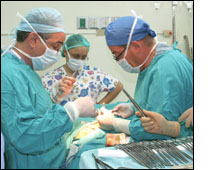Carl Valenziano, MD
Dominican Republic: April 2008

The following is a synopsis of my surgical mission, week of 4/7/2008, in the Dominican Republic.
Arriving in Santo Domingo April 7 we went to the Office of the Foundation of Congressman Manuel Jimenez and saw several "pre-op" patients. Amongst these
were massive hernias, burn scars and other surgical issues, most of which we could care for during this week. The main operative days during this stay were
Tuesday and Thursday. Wednesday was unexpectedly eliminated because of a national strike. The patients on whom I operated ranged in age from 4 years to 60
years old. The cases ranged from ventral and umbilical hernias, including small children to adult inguinal hernias and gall bladder surgery. There were
also scar revisions and other minor cases during this week.
In continuation of the same project, I traveled to a poor community well known to me to identify additional patients for future visits and for any possible
needs to be have patients sent to the United States. Patients were also brought to the hotel for examination.
Identified through these efforts were several patients with significant problems. The first is a 12-year-old boy with a colostomy. First diagnosed with an
imperforate anus at the time of birth, there was no pediatric surgeon to conduct the proper surgery. He appears to have rectal musculature. There is a
chance we can conduct the surgery in the DR, but I am working with a foundation to possibly bring him back to the United States. Another is a patient who
had a breast biopsy, but apparently inadequate follow-up and now seems to have advanced breast cancer. She requires surgery that can be conducted in the
Dominican Republic. Since we did not want to wait for a follow-up visit by myself several months from now, it was arranged for her to meet with a Dominican
surgeon who specializes in breast surgery. We communicated with him and he agreed to care for her gratis. Another individual is a 31-year-old male who was
electrocuted with a main contact point being at the top of his skull. He had no neurologic deficit, but has a severe injury to his scalp and a large area
of necrosis to the top of his skull. A CT scan was obtained while I was there and I have returned with it to identify whether or not a craniofacial group
can assist in repair of his calvarium and scalp. Several other patients were identified for more routine general surgery.
Simultaneous with this visit, arrangements to create a better communication and patient identification system are being developed. A more routine
diagnostic and surgical program with the hospital of the Dominican Air Force is being worked out. I have worked with the Chairman of the Department of
Surgery there over the last couple of years. They have an excellent residency and a clinic with which he has promised to accommodate us and our patients in
exchange for incorporating and educating his residents. Additionally, I met with individuals from the U.S. Embassy with whom I hope that we can develop
better systems for delivering equipment and medicines with diminished problems with Dominican Customs. We are working through the U.S. Embassy, Dominican
Congressman Jimenez and the United States and Dominican Air Force to develop better delivery systems for surgical equipment and medications.
I thank the Ben Josephson Fund for the support it has provided. Over the coming years, I hope I can demonstrate the greater fruit of this small seed.